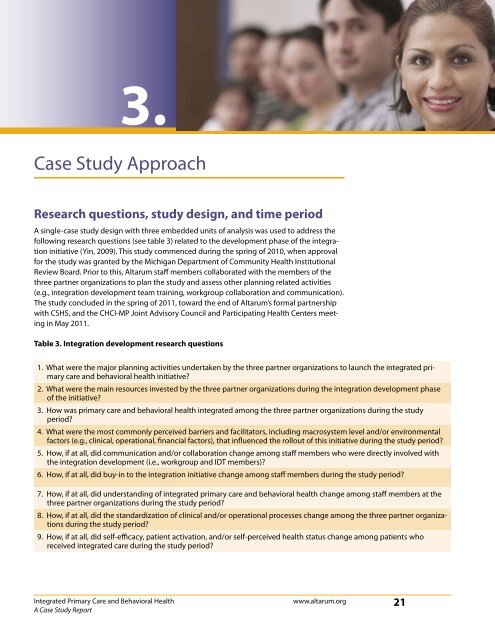A Case Study Report - Altarum Institute
A Case Study Report - Altarum Institute
A Case Study Report - Altarum Institute
Create successful ePaper yourself
Turn your PDF publications into a flip-book with our unique Google optimized e-Paper software.
3.<br />
<strong>Case</strong> <strong>Study</strong> Approach<br />
Research questions, study design, and time period<br />
A single-case study design with three embedded units of analysis was used to address the<br />
following research questions (see table 3) related to the development phase of the integration<br />
initiative (Yin, 2009). This study commenced during the spring of 2010, when approval<br />
for the study was granted by the Michigan Department of Community Health Institutional<br />
Review Board. Prior to this, <strong>Altarum</strong> staff members collaborated with the members of the<br />
three partner organizations to plan the study and assess other planning related activities<br />
(e.g., integration development team training, workgroup collaboration and communication).<br />
The study concluded in the spring of 2011, toward the end of <strong>Altarum</strong>’s formal partnership<br />
with CSHS, and the CHCI-MP Joint Advisory Council and Participating Health Centers meeting<br />
in May 2011.<br />
Table 3. Integration development research questions<br />
1. What were the major planning activities undertaken by the three partner organizations to launch the integrated primary<br />
care and behavioral health initiative?<br />
2. What were the main resources invested by the three partner organizations during the integration development phase<br />
of the initiative?<br />
3. How was primary care and behavioral health integrated among the three partner organizations during the study<br />
period?<br />
4. What were the most commonly perceived barriers and facilitators, including macrosystem level and/or environmental<br />
factors (e.g., clinical, operational, financial factors), that influenced the rollout of this initiative during the study period?<br />
5. How, if at all, did communication and/or collaboration change among staff members who were directly involved with<br />
the integration development (i.e., workgroup and IDT members)?<br />
6. How, if at all, did buy-in to the integration initiative change among staff members during the study period?<br />
7. How, if at all, did understanding of integrated primary care and behavioral health change among staff members at the<br />
three partner organizations during the study period?<br />
8. How, if at all, did the standardization of clinical and/or operational processes change among the three partner organizations<br />
during the study period?<br />
9. How, if at all, did self-efficacy, patient activation, and/or self-perceived health status change among patients who<br />
received integrated care during the study period?<br />
Integrated Primary Care and Behavioral Health www.altarum.org 21<br />
A <strong>Case</strong> <strong>Study</strong> <strong>Report</strong>


